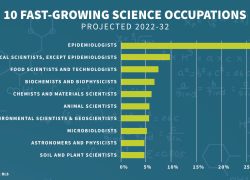September is National Preparedness Month, which focuses on planning to minimize damage that may result from natural disasters or other emergencies. But for many workers, emergency preparedness is more than a month: It’s their career.
The Bureau of Labor Statistics projects strong employment growth from 2022 to 2032 in the six occupations featured here, from 26.7% for epidemiologists to 3.3% for emergency management directors. (The average projected for all occupations is 2.8%.)

If helping people plan for, stay safe during or recover from a crisis sounds like the kind of work you would like to do, consider these occupations:
🥼 Epidemiologists collect and provide demographic health information before, during and after disasters for planning effective responses and treatment needs.
🚒 Fire inspectors and investigators review emergency evacuation plans and analyze evidence from scenes of fires and explosions.
📝 Social and human service assistants provide support for families and, in crisis situations, help clients identify and obtain benefits or community services.
🚑 Emergency medical technicians (known as EMTs) and paramedics assess injuries and illnesses, provide emergency medical care and may transport patients to medical facilities.
⛈️ Meteorologists collect, analyze, and monitor weather and climate data to issue daily forecasts and warnings for weather-related disaster prevention, such as storm watches.
🦺 Emergency management directors prepare plans and procedures for responding to natural disasters or other emergencies. They also help lead the response during and after emergencies.
Explore these and hundreds of other occupations in the Occupational Outlook Handbook. You’ll find career exploration and assessment tools at the U.S. Department of Labor’s O*NET Resource Center.
Patricia Tate is an economist in the U.S. Bureau of Labor Statistics. Follow BLS on X at @BLS_gov.

 U.S. Department of Labor Blog
U.S. Department of Labor Blog





